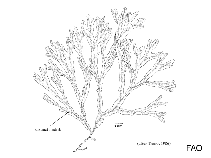Dictyota ciliolata Sonder ex Kützing
| Native range | All suitable habitat | Point map | Year 2050 |

|
| This map was computer-generated and has not yet been reviewed. |
| Dictyota ciliolata AquaMaps Data sources: GBIF OBIS |
Upload your photos
Google image | No image available for this species;
drawing shows typical species in Dictyotaceae.
Google image | No image available for this species;
drawing shows typical species in Dictyotaceae.
Classification / Names Common names | Synonyms | CoL | ITIS | WoRMS
| Dictyotales | Dictyotaceae
Environment: milieu / climate zone / depth range / distribution range Οικολογία
. Tropical
Κατανομή Χώρες | Περιοχές FAO | Οικοσυστήματα | Παρουσίες | Εισαγωγές
Atlantic and Western Indian Ocean: USA south to Brazil, Spain to Gabon; Indo-Central Pacific Ocean.
Length at first maturity / Μέγεθος / Βάρος / Age
Maturity: Lm ? range ? - ? cm Max length : 8.0 cm TL αρσενικό/απροσδιόριστο; (Ref. 82093)
Short description Μορφολογία
Thalli are erect, to 8 cm tall, attached by means of a single stupose holdfast. Stolonoidal fibres are absent. Straps, 2-3 mm wide, are slender and dichotomously branched. The margins are dentate, rarely smooth, while the surface is always smooth. The apices are rounded. The medulla and cortex are uniformly one-layered. Sporangia are single, scattered on both surfaces, but absent in the apical dichotomies. Sporangia, 95-110 μm in diameter, are borne on a single stalk cell and are not surrounded by a conspicuous involucrum (Ref. 82093). Dictyota ciliolata is characterised by its stupose holdfast, dentate margins and the absence of stolonoidal fibres, although the margins of some specimens can be nearly smooth (Hörnig et al. 1992a,b) (Ref. 82093).
Dictyota ciliolata is characterised by its stupose holdfast, dentate margins and the absence of stolonoidal fibres, although the margins of some specimens can be nearly smooth (Hörnig et al. 1992a,b). (Ref. 82093) Specimens were collected in intertidal pools of the sublittoral fringe down to -12 m (Ref. 82093).
Life cycle and mating behavior Γεννητική Ωρίμανση | Αναπαραγωγή | Γεννοβολία | Αβγά | Γονιμότητα | Προνύμφες
Main reference
Αναφορές | Συντονιστής | Συνεργάτες
Guiry, M.D. and G.M. Guiry. 2009. (Ref. 80701)
IUCN Red List Status (Ref. 130435)
CITES status (Ref. 108899)
Not Evaluated
CMS (Ref. 116361)
Not Evaluated
Threat to humans
Human uses
| FishSource |
Εργαλεία
Περισσότερες πληροφορίες
Διαδικτυακές πηγές
BHL | BOLD Systems | CISTI | DiscoverLife | FAO(Publication : search) | Fishipedia | GenBank (genome, nucleotide) | GloBI | Gomexsi | Google Books | Google Scholar | Google | PubMed | AlgaeBase | Δέντρο Ζωής | Wikipedia (Go, αναζήτηση) | Zoological Record



